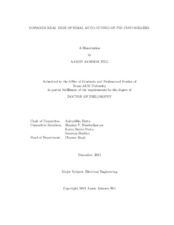| dc.contributor.advisor | Datta, Aniruddha | |
| dc.creator | Hill, Aaron Jamison | |
| dc.date.accessioned | 2014-05-13T17:07:45Z | |
| dc.date.available | 2014-05-13T17:07:45Z | |
| dc.date.created | 2013-12 | |
| dc.date.issued | 2013-08-22 | |
| dc.date.submitted | December 2013 | |
| dc.identifier.uri | https://hdl.handle.net/1969.1/151639 | |
| dc.description.abstract | The Proportional-Integral-Derivative (PID) controller has been widely used by the process control industry for many years. Design methods for PID Controllers are mature and have been heavily researched and evaluated. For most of its modern history the Ziegler-Nichols methods have been used for tuning PID controllers into desired operating conditions. Recently, automatic tuning methods have been formulated and used to generate stable PID controlled systems. These methods have also been implemented on real time systems. However, the use of optimal methods for auto tuning PID controllers on real time systems has not seen much discussion. In this thesis we explore the applicability of optimal PID design methods from Datta, Ho, and Bhattacharrya, to real time system control. The design method is based on a complete characterization of the set of stabilizing PID parameters for various plant models and a subsequent search over the stabilizing set for the optimal controller. A full implementation of the algorithms is completed on an embedded system with DSP hardware. These implementations are then tested against a large number of examples to determine both accuracy and applicability to real time systems.
The major design constraint for application of these algorithms to real time systems is computation time. The faster the optimal result can be computed the more applicable the algorithm is to a real time environment. In order to bring each of these algorithms into a real time system, fast search algorithms were developed to quickly compute the optimal result for the given performance criterion. Three different search methods were developed, compared and analyzed. The first method is a brute force search used as a basis to compare the two additional fast search methods. The two faster search methods prove to be vastly superior in determining the optimal result with the same level of accuracy as brute force search, but in a greatly reduced time. These search methods achieve their superior speeds by reducing the search space without sacrificing accuracy of the results. With these two fast search methods applied to the complete characterization of stabilizing PID controllers, application to real time systems is achieved and demonstrated through examples of various performance criteria. | en |
| dc.format.mimetype | application/pdf | |
| dc.language.iso | en | |
| dc.subject | PID controllers | en |
| dc.subject | real time systems | en |
| dc.subject | algorithms | en |
| dc.subject | auto-tuning | en |
| dc.subject | embedded systems | en |
| dc.subject | characterization of stabilizing set for PID | en |
| dc.title | Towards Real Time Optimal Auto-tuning of PID Controllers | en |
| dc.type | Thesis | en |
| thesis.degree.department | Electrical and Computer Engineering | en |
| thesis.degree.discipline | Electrical Engineering | en |
| thesis.degree.grantor | Texas A & M University | en |
| thesis.degree.name | Doctor of Philosophy | en |
| thesis.degree.level | Doctoral | en |
| dc.contributor.committeeMember | Bhattacharyya, Shankar P | |
| dc.contributor.committeeMember | Butler-Purry, Karen | |
| dc.contributor.committeeMember | Swaroop, Dabrha | |
| dc.type.material | text | en |
| dc.date.updated | 2014-05-13T17:07:45Z | |


